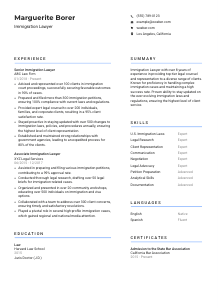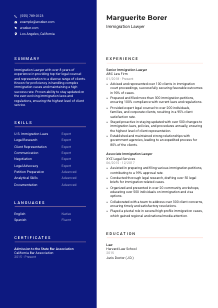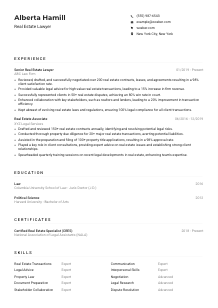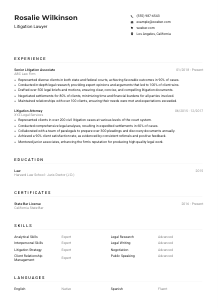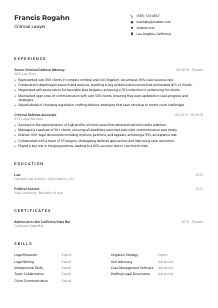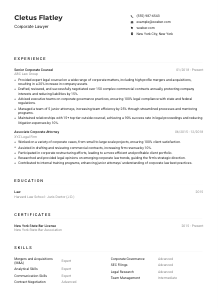Immigration Lawyer Resume Example
Navigating complex cases, but your resume feels like it's stuck at the border? Discover this Immigration Lawyer resume example, structured with Wozber free resume builder. Learn how to showcase your legal expertise to align with job requirements, making your career journey as smooth as securing that coveted stamp in a passport!
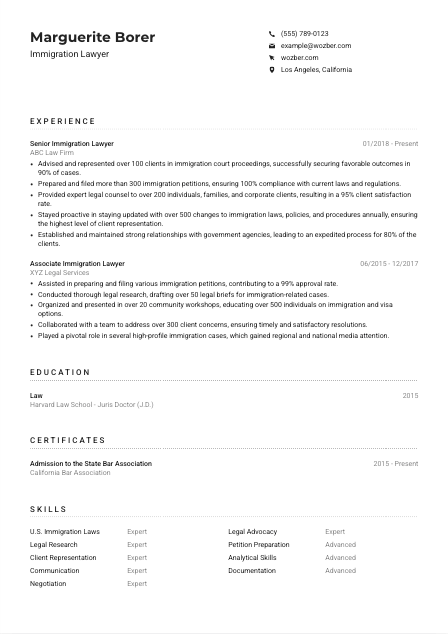
How to write an Immigration Lawyer resume?
Embarking on the path to becoming an Immigration Lawyer is a noble and challenging journey. As you prepare to dive into the competitive job market, your resume serves as your passport, showcasing your legal expertise, experience, and dedication to navigating the complexities of immigration law. This tailored guide, powered by the capabilities of Wozber free resume builder, leads you through crafting a resume that's not simply a list of achievements, but a compelling narrative that aligns perfectly with the specific requirements of an Immigration Lawyer position.
Are you ready to create an ATS-optimized resume that opens doors? Let's begin this transformative journey together.
Personal Details
The Personal Details section is your resume's opening statement. It's where you first catch the eye of hiring managers, so it's paramount to tailor it perfectly for an Immigration Lawyer role. Discover how to make each word count, setting the professional tone for the rest of your document.
1. Embrace Your Professional Identity
Start strong with your name in a clear, professional font. Position it proudly at the top, symbolizing your personal brand. Immediately after, align your professional identity with the role by positioning 'Immigration Lawyer' underneath your name, echoing the job title directly.
2. Make Contact Details Count
Include your most reliable contact number and a professional email, such as firstname.lastname@email.com. Accuracy is key, as even a single typo might mean a missed opportunity.
3. Localize Your Application
"Must be located in Los Angeles, California" isn't just a preference; it's a requirement. By flagging 'Los Angeles, California' prominently in your contact details, you instantly match one of the job's non-negotiables.
4. Showcase Your Digital Footprint
A well-maintained LinkedIn profile can serve as an extension of your resume. Ensure it's updated and reflects the same level of professionalism. This links your application to a broader narrative of your career journey.
5. Privacy is Paramount
Avoid personal data not directly relevant to your application. This not only protects your privacy but also keeps the focus on your qualifications and suitability for the role of Immigration Lawyer.
Takeaway
The Personal Details section is where impressions are formed. Make it count by ensuring it's professionally tailored to your desired role as an Immigration Lawyer. This is your introduction, your first step in the door. Make it a reflection of your professionalism and readiness for the role at hand.





Experience
The Experience section is where you showcase your journey and qualifications in immigration law. Let's delve into precisely tailoring this section, demonstrating not just your experience, but how it equips you perfectly for the responsibilities of an Immigration Lawyer.
- Advised and represented over 100 clients in immigration court proceedings, successfully securing favorable outcomes in 90% of cases.
- Prepared and filed more than 300 immigration petitions, ensuring 100% compliance with current laws and regulations.
- Provided expert legal counsel to over 200 individuals, families, and corporate clients, resulting in a 95% client satisfaction rate.
- Stayed proactive in staying updated with over 500 changes to immigration laws, policies, and procedures annually, ensuring the highest level of client representation.
- Established and maintained strong relationships with government agencies, leading to an expedited process for 80% of the clients.
- Assisted in preparing and filing various immigration petitions, contributing to a 99% approval rate.
- Conducted thorough legal research, drafting over 50 legal briefs for immigration‑related cases.
- Organized and presented in over 20 community workshops, educating over 500 individuals on immigration and visa options.
- Collaborated with a team to address over 300 client concerns, ensuring timely and satisfactory resolutions.
- Played a pivotal role in several high‑profile immigration cases, which gained regional and national media attention.
1. Aligning With Job Requirements
Scrutinize the job description for an Immigration Lawyer. Notice the emphasis on 'experience in immigration law, preferably with a focus on employment-based petitions and family-based immigration'? Your roles should reflect these specific areas of expertise, relating directly back to these critical requirements.
2. Detailing Your Roles
Begin with your most recent position, clearly listing your title, the firm's name, and your tenure. This chronological format not only highlights your progression but also aligns with the ATS's expectations for clarity and straightforwardness.
3. Quantifying Success
Bring your achievements to life with numbers, such as 'advised and represented over 100 clients in immigration court proceedings, securing favorable outcomes in 90% of cases.' This specificity adds weight to your accomplishments, making them more tangible and impactful.
4. Matching Responsibilities
For each role, tailor your bullet points to match the listed responsibilities. If the job description emphasizes 'Prepare and file a range of immigration petitions,' detail your direct experience and successes in this area, demonstrating a seamless fit.
5. Relevance is Key
While that ping-pong championship might be a proud moment, reserve the space on your resume for directly relevant experiences. Every bullet point should serve the purpose of echoing the job's requirements.
Takeaway
Your Experience section is a powerful tool, not just to list where you've worked, but to vividly illustrate how each role has prepared you for the challenges and responsibilities of an Immigration Lawyer. Tailor, quantify, and align your experience with the job requirements, shaping a narrative that leaves no doubt you're the right choice for the position.
Education
The journey to becoming an Immigration Lawyer starts with a solid educational foundation. The Education section of your resume isn't merely a formality; it's a testament to your preparedness and dedication to the field. Let's outline how to present your academic achievements in a way that resonates with hiring managers.
1. Spotlight on Key Qualifications
"Juris Doctor (J.D.) from an accredited law school" isn't just a line in the job description; it's a pivotal requirement. Ensure this qualification is front and center in your Education section, perfectly matching the job's specifications.
2. Simple, Yet Effective Formatting
Organize your educational background clearly: list each degree, followed by the field of study, the institution, and your graduation year. This straightforward format meets ATS requirements and makes it easy for hiring managers to verify your qualifications.
3. Tailoring Your Degree
If the role expressly asks for a particular degree, like the Juris Doctor for this Immigration Lawyer position, ensure it is correctly listed on your resume. This accuracy is key to passing the ATS scan and meeting the hiring manager's expectations.
4. Relevant Coursework and Honors
In certain cases, listing relevant coursework, honors, or involvement in law-related activities can bolster your profile, especially if these experiences directly enhance your suitability for the role.
5. Valuing Other Educational Achievements
While the focus should be on the primary educational requirement, don't shy away from mentioning additional courses, certificates, or degrees that highlight your commitment to ongoing learning and professional development.
Takeaway
Your Education section does more than list your degrees; it showcases the foundation upon which your entire career is built. By tailoring this section to echo the job requirements precisely, you demonstrate not only compliance but a deep-rooted commitment to the field of immigration law.
Certificates
In the competitive field of immigration law, certificates are more than accolades; they're evidence of your dedication to staying at the forefront of legal developments. Whether it's continuous education or specialized training, let's explore how to showcase your certifications in alignment with the Immigration Lawyer role.
1. Identifying Relevant Certifications
Start by understanding the job description's silent cues. While specific certifications might not be explicitly required, listing certifications like 'Admission to the State Bar Association' directly supports your qualification for the role, underscoring your legal standing and expertise.
2. Prioritizing Pertinent Certifications
Choose to list certifications that hold the most weight for an Immigration Lawyer position. This focus ensures that hiring managers immediately see the certifications most relevant to the job at hand, enhancing your candidacy.
3. Dates Matter
Where applicable, include the acquisition or validity dates of your certifications. This transparency shows you're up-to-date with your qualifications and ready to hit the ground running.
4. Continual Learning
The legal landscape is ever-evolving, and so should your certifications. Show your commitment to growth by highlighting recent certifications or ongoing education relevant to immigration law.
Takeaway
Your certificates are a testament to your ongoing quest for excellence and relevance in the field of immigration law. By carefully selecting and presenting certifications that underscore your expertise and commitment, you add another layer of credibility to your application, distinguishing you as a prime candidate.
Skills
The Skills section may be brief, but its importance cannot be overstated. It's a snapshot of your professional toolkit, tailored to catch the eye of both the ATS and the hiring manager. Let's apply a strategic approach to listing the skills that make you a standout Immigration Lawyer.
1. Matching Skills to Job Requirements
Scour the job listing for skills and competencies. Align these with your own skillset, particularly highlighting areas such as 'U.S. Immigration Laws,' 'Legal Research,' and 'Client Representation.' These skills directly address the requirements within the job description, sealing your fit for the role.
2. Focusing on the Essentials
While you might possess a broad range of abilities, concentrate on listing those most relevant to being an Immigration Lawyer. This targeted approach ensures your resume is streamlined and directly speaks to the needs of the employer.
3. Creating an ATS-Friendly Layout
Ensure your skills are listed in a simple, easy-to-scan format. Using bullet points and consistent formatting aligns with ATS optimization, making sure your resume doesn't get lost in the shuffle.
Takeaway
The Skills section of your resume is a finely honed list of the weapons in your professional arsenal. By strategically aligning it with the job requirements, you not only prove your capability but also speak the language of the ATS, ensuring your resume stands out in the digital and human evaluation. Remember, every skill you list is both a promise and a testament to your potential as an Immigration Lawyer.
Languages
In the domain of immigration law, language proficiency can significantly amplify your effectiveness and client relations. This section explores how to highlight your linguistic capabilities to stand out as an Immigration Lawyer, particularly when dealing with diverse communities and international clients.
1. Pinpointing Job Language Requirements
The job description specifies 'Proficiency in English language for professional communication is essential.' Prioritize this in your Languages section, but also take the opportunity to highlight additional languages you are fluent in, like Spanish, enhancing your appeal to a broader client base.
2. Structuring Language Proficiencies
Start with the languages most relevant to the job. For an Immigration Lawyer position in Los Angeles, California, listing English followed by any additional languages such as Spanish can significantly bolster your application.
3. Being Honest About Your Level
Clearly indicate your proficiency levels for each language. Whether you're 'Native,' 'Fluent,' 'Intermediate,' or possess 'Basic' skills, transparency ensures that expectations are aligned with reality.
4. Recognizing the Role's Scope
In immigration law, the ability to communicate across languages can be a distinct advantage. Emphasize your multilingual skills if the role involves interacting with international or diverse client populations.
5. Continuous Improvement
Show a commitment to professional growth by pursuing further language learning relevant to your target demographic. This dedication can set you apart as an Immigration Lawyer deeply invested in serving clients effectively.
Takeaway
As an Immigration Lawyer, your ability to bridge language barriers is a powerful tool in connecting with clients and navigating the intricacies of immigration law. Highlighting your linguistic skills not only underscores your resume but also demonstrates your preparedness to engage with a diverse and global clientele. Let your language skills shine as a testament to your expansive professional capabilities.
Summary
Your resume's Summary section offers a valuable opportunity to distill your professional identity into a compelling narrative. Tailoring this essential component for an Immigration Lawyer role, let's encapsulate your experiences, skills, and aspirations, inviting the reader to explore the depth of your candidacy.
1. Digesting the Job Essence
Begin by absorbing the key elements of the job description. Identify the core responsibilities and requirements of an Immigration Lawyer, using these insights to inform the tone and content of your summary.
2. Crafting Your Introduction
Lead with a concise statement that frames you as an adept Immigration Lawyer. Highlight your years of experience and areas of specialization, directly addressing the primary requirements of the job.
3. Showcasing Key Achievements
Feature a selection of your most pertinent skills and accomplishments. For instance, "Known for proficiency in handling complex immigration cases and maintaining a high success rate," directly echoes critical job requirements, positioning you as an ideal candidate.
4. Concision is the Key
Your summary should be a teaser, not a tell-all. Aim for 3-5 impactful lines that captivate interest and encourage a reader to delve deeper into your resume.
Takeaway
Consider your Summary section as the professional handshake that precedes an enriching conversation. By crafting it with intention, reflecting the essence of the job description, and highlighting your unique qualifications, you set the stage for a resume that resonates deeply with hiring managers, paving the way for opportunities as an Immigration Lawyer.
Embarking on Your Journey as an Immigration Lawyer
Congratulations on taking this comprehensive journey through crafting a bespoke resume for an Immigration Lawyer position. With these tailored strategies, powered by Wozber's free resume builder, ATS-friendly resume templates, and ATS resume scanner, you're well-equipped to create a document that not only meets the exacting standards of Applicant Tracking Systems but also captivates the human eye. Your resume is now a polished testament to your expertise, ready to pave your path to success in the challenging yet rewarding field of immigration law.
Your dedication and preparation set you apart. Now, step forward with confidence, knowing your resume is as compelling and purposeful as the career you're pursuing.

- Juris Doctor (J.D.) from an accredited law school.
- Admission to the State Bar association and active license to practice law.
- Minimum of 5 years' experience in immigration law, preferably with a focus on employment-based petitions and family-based immigration.
- In-depth knowledge and understanding of U.S. immigration laws, regulations, and procedures.
- Exceptional analytical, research, and communication skills, both written and verbal.
- Proficiency in English language for professional communication is essential.
- Must be located in Los Angeles, California.
- Advise and represent clients in immigration court proceedings, including removal hearings, appeals, and administrative proceedings.
- Prepare and file a range of immigration petitions, applications, and supporting documentation, ensuring compliance with current laws and regulations.
- Provide legal counsel to individuals, families, and corporate clients on all matters related to immigration and visa options.
- Stay updated on changes to immigration laws, policies, and procedures, and inform clients accordingly.
- Liaise with government agencies and officials to address client concerns, expedite processes, and ensure proper handling of cases.






